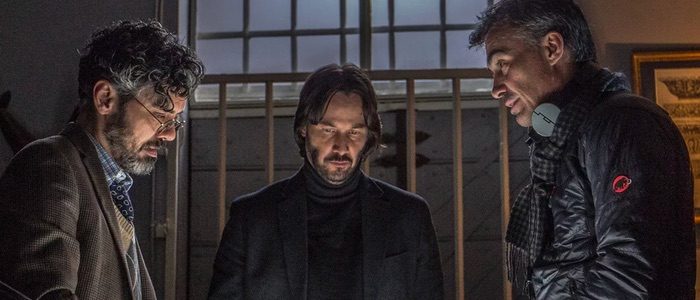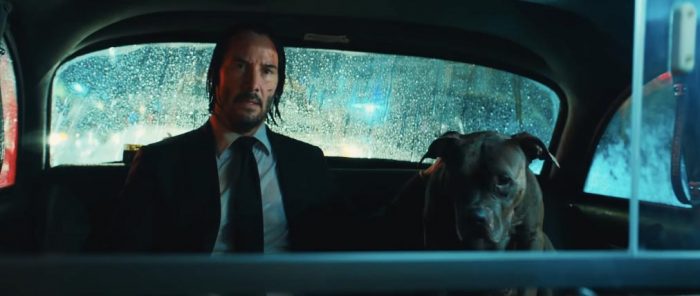‘John Wick’ Franchise Director Chad Stahelski Talks Shooting Action and Building Characters in a Spoiler-Heavy Interview

The summer movie season will remain abuzz after the triumphant arrival of John Wick: Chapter Three – Parabellum. If ever a movie could be a mic drop, it’s the latest chapter of everybody’s new favorite killing machine and dog enthusiast, John Wick. The sequel has it all, starting with another performance from Keanu Reeves that leaves a big fat mark on pop culture.
Director Chad Stahelski attributes the success of the franchise to Reeves, whom he’s been working with ever since The Matrix. When Stahelski says the actor is giving every frame his all in this movie, nobody could ever question that. Reeves brings a believability to the poetic and ridiculous action, a sincerity to the drama, and a powerful presence and sense of ownership to the role. In another actor’s hands, John Wick, as we’ve come to know and love him, wouldn’t be John Wick.
During our wide-ranging interview with Stahelski following the franchise’s biggest opening at the box-office yet, he told us why audiences connect with Reeves as Wick, how he always goes for beauty in his movies, how he shoots action, and more.
Telling John Wick’s stories in chapters rather than a trilogy, what sort of freedom does that give you? Is it less restrictive?
If you’re familiar with any of the other films, we try to do storytelling a little different than just having a plot-based film or a three-act. We often joke saying we have two acts: man and mission. I’m a big fan of the Kurosawa stuff, I’m a big fan of Sergio Leone, which instead of plot it’s more about journey. You follow a week in the life of an assassin, and John Wick takes you through our world.
Rather than doing this whole massive character arc, we try to stay to thematics, and it’s about grief and consequence, so that’s really where the conversation starts. What are our options? What would John Wick actually do? What would we do if we were John Wick? What’s the normal thing? Try to turn it on its head, and react as if you’re really in the story. That’s kind of how we get the endings we do, and how we get John’s motivation. That’s really where it starts is dealing with that.
Since they’re chapters, it’s not a third movie that needs closure, him dying or him finding peace and living in a cabin. But another ending at one point was considered, right? What was it?
We’re talking way back in development. Nothing that was actually scripted. But originally, we were trying to break the timeline, and there’s a little joke behind the cameras, we didn’t have any plans other than one film at a time. When we did John Wick 1. My colleague, Dave Leitch, and I, we figured that was the end of it. We’ll be lucky if we can get a directing job again. We did Chapter Two, and it was the same thing, so Keanu and I were like, “We’ll never work again.”
Whereas Chapter Three, we’re like, “Oh, okay.” We just look at it like, “Okay, the guy’s done this incredible journey. He killed hundreds of people. There is no way this guy rides off into the sunset. It’s not going to be a happy ending.” There’ll be an ending and moments of levity, but any comedy’s a tragedy, any tragedy’s a comedy, depending on where you look at the endpoint. And then we were like, “Okay. Where is the only way out this guy can go?”
When we started conceiving number three, we’re like, “Look, dude, you can’t beat the High Table. You can’t beat karma. You can’t beat fate.” Now, in how it ends, there are remnants of our idea in the speech with Winston in the glass house. You know — it’s not about who do you choose to live as, but it’s who do you choose to die as. And that was the theme we were going to try to end the movie with John Wick’s choice of not who he wants to live as, but who he wants to die as, and he wants to die as somebody honorable, somebody that his wife can be proud of.
With the ending, I like to think he’s going back to who he once was, the old John Wick. To you and Keanu Reeves, who was the old John Wick?
In the first movie, when he goes into the bathhouse, that was remnants of who John Wick was before he met his wife. Someone that, whether on purpose or mistakenly tried to live his life with that coldness and harshness, that determination to carry out a task, as opposed to filling it with love and passion. Yeah, it’s been dwelling in all of us. How do you fill your day, with love and hate, hate and remorse, or is it hope and value and honor? It’s all those many things mixed into a very simplistic journey of a guy to finding who he is. He can see all the mirrors and the reflections, so there’s always going to be some level of duality.
John Wick before now is probably a very empty person inside, too. Lots of talk, lots going on in the mind, but an empty heart. After that, he’s experienced and has something they’re jealous of, but you get a common consequence, and he can’t fully realize that. Where we kick off in the first movie, I’m sure he’s very conflicted about who he is or who he should become. So hopefully, the John Wick you see at the end of the third film, he’s a completely new character than you saw in the beginning, middle or end of either of the first two movies.

You feel the punches he takes in this movie. The brutality has a little more sting to it, like the knife in the eye or something more subtle like a dancer peeling her toenail off. What made you want to go a bit harder with the violence?
I get that, and I totally see where you’re coming from. I’ve been choreographing so long, and I don’t mean to sound like it’s dehumanizing or I’m insensitive to it—there are levels of movie violence that I don’t wanna experience. I have my limits as well. The action in the movie, I’m not really looking at that. I’m not looking for gore, I’m not looking for shock value, I’m not even looking for psychological torment. I’m just looking, okay, a guy gets stabbed in the eye because it’s fragile. Any special forces guy, law enforcement, military knows the headshots are very, very prevalent in current gun work. So, we just do what normal people do real. You run out of bullets, shoot people in the head. So we try to do that.
If you get in a knife fight the head, the neck, the throat, things that you don’t really see in movies, those are legitimate targets and those are things that they do, so we just do that. We weren’t conscious of trying to up ourselves in terms of violence; we just choreographed and then we spawned the effects and the consequences due to what we choreographed.
In terms of the theater of pain and the toenail, that’s my Nietzsche coming out. Our pain, life is suffering, I totally believe that. One hundred percent I believe that. I’m a big Nietzsche fan. I believe in the Joseph Campbell, fractured hero, put the guy in a theater of pain. The more you beat him up, you feel like John is paying for what he’s doing. You can only shoot so many people. Because he does this stuff, he’s actually paying for it. Karma is slapping him back and that makes it more justifiable what we do with John.
Also, it’s a little tribute to a lot of dance choreographers like Bob Fosse to ballet choreographers I get great influence from. Martial arts choreography for film is a hundred times more like dance than it is about competitive martial arts, combative martial arts. So, if you’ve ever gone behind the scenes and watched ballerinas training and watched the abuse, they’re some of the toughest athletes on the planet in my mind. So, it’s not just the soft tippy toe stuff — they’re freaking hardcore athletes and you just wanna show what they go through, and breaking off toenails was one of them. It’s also a character trained to shoot, you’re gonna deal with the Russian Ruska Roma, the Russian gypsies mob or assassins or up and comers, then that’s the level of toughness you’re gonna have.
Was the school John returns to at all inspired by Jackie Chan’s childhood at the Peking Opera School?
Yeah, it’s a good analogy. It’s been brought up several times to me over the film. Great comparison. Was it really inspired that way? I think it’s a good comparison, I wish it was. I wish I was that clever.
[Laughs] Since this is your third film and your second sequel, what are the biggest logistical and creative challenges in making a successful sequel, especially in regard to Chapter Three?
There are logistics: how much money, how much time. We trade money for time. You start with so many days and then because you want to do New York and you want a glass house, you start neutering certain resources to put other places, and that is always a challenge, but certainly not the biggest. Every film goes through some logistical and scheduling frustration.
We’re basically creating an original property; it doesn’t have a comic book or a book. Literally me, Keanu and one of our department heads or one of our writing staff coming up with ideas to build this world out. It started small and we kinda grew, but there’s the temptation to revert back to what people laughed at in the first one and bring back the same characters and do the same gags. Play it safe, do the same kind of action, and then there’s the challenge of, can we do better? Can we do something a little different? They call it the curse of the sequel. They love the first movie because it’s original, but by its very nature, the sequel can’t be original in the same way as the first one is because it’s a sequel [Laughs]. So how do you become original, how do you keep the audience invested in what they love and at the same time, show them something new? They want to see it again, but they don’t want you to repeat exactly. It’s that fine line, and for any filmmaker doing a sequel, whether it’s their own original thing or stepping into somebody else’s shoes or following in someone else’s shoes, that to me is probably the biggest challenge.
To tell you the truth, it scared me shitless. There’s not one of these I haven’t been on literally feeling nauseous every day on set. Am I doing enough? Am I doing too much? Am I going too far off the track by expanding this? And that’s always the thing in a John Wick movie. No rules, but at the same time, you gotta keep it contained but still open. It’s the weirdest feeling ever creatively, and that’s absolutely the biggest obstacle.
Continue Reading John Wick >>
The post ‘John Wick’ Franchise Director Chad Stahelski Talks Shooting Action and Building Characters in a Spoiler-Heavy Interview appeared first on /Film.
from /Film http://bit.ly/2JReX6M
via IFTTT
Comments
Post a Comment